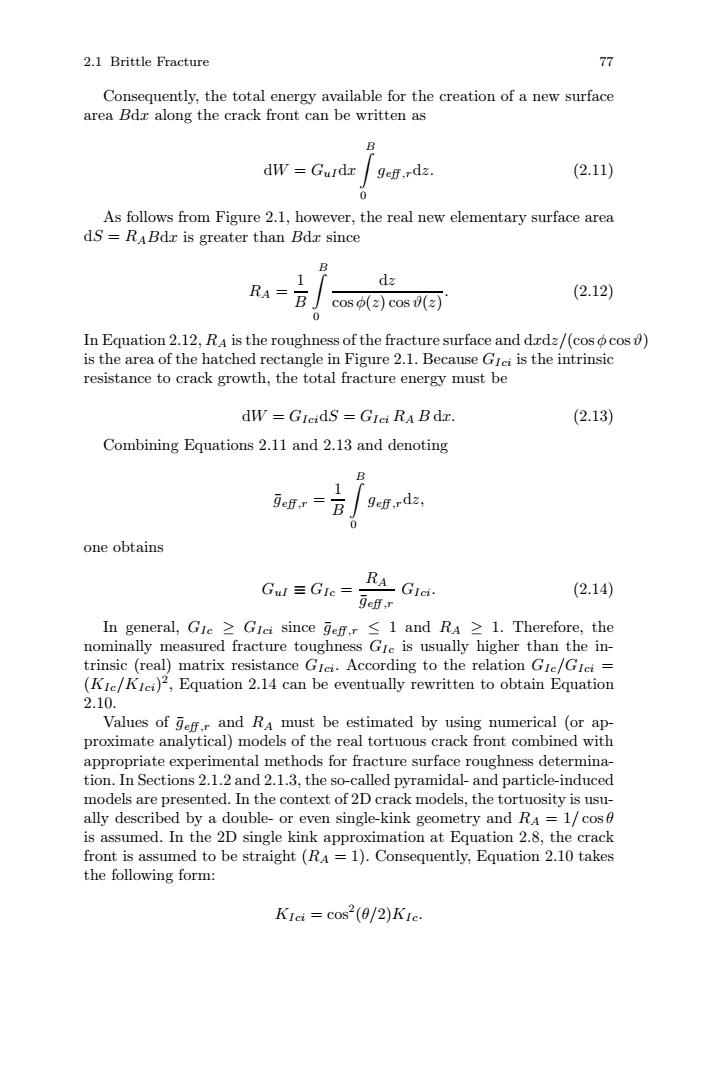正在加载图片...

2.1 Brittle Fracture 77 Consequently,the total energy available for the creation of a new surface area Bdx along the crack front can be written as B dW Gurdz 9eff,rdz. (2.11) 0 As follows from Figure 2.1,however,the real new elementary surface area dS=RABdz is greater than Bdr since dz RA B (2.12) coso(z)cos(z) In Equation 2.12,RA is the roughness of the fracture surface and drdz/(cos ocos) is the area of the hatched rectangle in Figure 2.1.Because GIci is the intrinsic resistance to crack growth,the total fracture energy must be dW GIcidS GIci RA B dt. (2.13) Combining Equations 2.11 and 2.13 and denoting ⊙ gef.r= B gef,rdz, 0 one obtains GuI≡GIc= RA GIei. (2.14) geff.r In general,,Gie≥GIei since geff,r≤1 and RA≥1.Therefore,.the nominally measured fracture toughness Gic is usually higher than the in- trinsic (real)matrix resistance GIci.According to the relation Gre/GIci (KIe/KIci)2,Equation 2.14 can be eventually rewritten to obtain Equation 2.10. Values of gefr and RA must be estimated by using numerical (or ap- proximate analytical)models of the real tortuous crack front combined with appropriate experimental methods for fracture surface roughness determina- tion.In Sections 2.1.2 and 2.1.3,the so-called pyramidal-and particle-induced models are presented.In the context of 2D crack models,the tortuosity is usu- ally described by a double-or even single-kink geometry and RA =1/cos is assumed.In the 2D single kink approximation at Equation 2.8,the crack front is assumed to be straight (RA =1).Consequently,Equation 2.10 takes the following form: KIci=cos2(0/2)KIc.2.1 Brittle Fracture 77 Consequently, the total energy available for the creation of a new surface area Bdx along the crack front can be written as dW = GuIdx B 0 geff ,rdz. (2.11) As follows from Figure 2.1, however, the real new elementary surface area dS = RABdx is greater than Bdx since RA = 1 B B 0 dz cos φ(z) cos ϑ(z) . (2.12) In Equation 2.12, RA is the roughness of the fracture surface and dxdz/(cos φ cos ϑ) is the area of the hatched rectangle in Figure 2.1. Because GIci is the intrinsic resistance to crack growth, the total fracture energy must be dW = GIcidS = GIci RA B dx. (2.13) Combining Equations 2.11 and 2.13 and denoting g¯eff ,r = 1 B B 0 geff ,rdz, one obtains GuI ≡ GIc = RA g¯eff ,r GIci. (2.14) In general, GIc ≥ GIci since ¯geff ,r ≤ 1 and RA ≥ 1. Therefore, the nominally measured fracture toughness GIc is usually higher than the intrinsic (real) matrix resistance GIci. According to the relation GIc/GIci = (KIc/KIci)2, Equation 2.14 can be eventually rewritten to obtain Equation 2.10. Values of ¯geff ,r and RA must be estimated by using numerical (or approximate analytical) models of the real tortuous crack front combined with appropriate experimental methods for fracture surface roughness determination. In Sections 2.1.2 and 2.1.3, the so-called pyramidal- and particle-induced models are presented. In the context of 2D crack models, the tortuosity is usually described by a double- or even single-kink geometry and RA = 1/ cos θ is assumed. In the 2D single kink approximation at Equation 2.8, the crack front is assumed to be straight (RA = 1). Consequently, Equation 2.10 takes the following form: KIci = cos2(θ/2)KIc.���